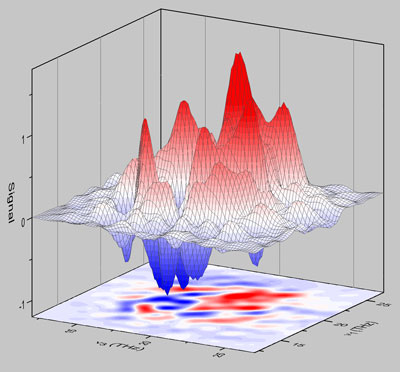| Aug 05, 2011 |
Electrons and lattice vibrations - a strong team in the nano world
|
|
(Nanowerk News) Using a newly developed type of spectroscopy, Berlin researchers have shown that electrons in a semiconductor are best described as a cloud with a size of a few nanometer. The cloud size is determined by the interaction of the electron with vibrations in the crystal lattice.
|
 |
| Measured two-dimensional spectrum. Without the interaction of the electron with lattice vibrations there would be no signal in the range shown.
|
|
Semiconductor electronics generates, controls, and amplifies electrical current in devices like the transistor. The carriers of the electric current are mobile electrons, which move with high velocities through the crystal lattice of the semiconductor. Doing this, they lose part of their kinetic energy by causing atoms in the lattice to vibrate. In semiconductors like gallium arsenide the positively and negatively charged ions of the crystal lattice vibrate with an extremely short period of 100 fs (1 fs = 10-15 s = 1 billionth part of one millionth of a second). In the microcosm of electrons and ions such vibrations are quantized. This means that the vibrational energy can only be an integer multiple of a vibrational quantum, also known as a phonon. When an electron interacts with the crystal lattice (the so called electron-phonon interaction), energy is transferred from the electron to the lattice in the form of such vibrational quanta.
|
|
Berlin researchers report in the latest issue of the scientific journal Physical Review Letters ("Strong Correlation of Electronic and Lattice Excitations in GaAs/AlGaAs Semiconductor Quantum Wells Revealed by Two-Dimensional Terahertz Spectroscopy") that the strength of the electron-phonon interaction depends sensitively on the electron size, i.e., on the spatial extent of its charge cloud. Experiments in the time range of the lattice vibration show that reducing the electron size leads to an increase of the interaction by up to a factor of 50. This results in a strong coupling of the movements of electrons and ions. Electron and phonon together form a new quasi particle, a polaron.
|
|
To visualize this phenomenon, the researchers used a nanostructure made from gallium arsenide and gallium aluminum arsenide, in which the energies of the movements of electrons and ions were tuned to each other. The coupling of both movements was shown by a new optical technique. Several ultrashort light pulses in the infrared excite the system under study. The subsequent emission of light by the moving charge carriers is measured in real time. In this way two-dimensional nonlinear spectra (see Fig.) are generated, which allow the detailed investigation of coupled transitions and the determination of the electron-phonon coupling strength. From the coupling strength one finds the size of the electron cloud, which is just 3-4 nanometers. Furthermore, this new method shows for the first time the importance of electron-phonon coupling for optical spectra of semiconductors. This is of interest for the development of optoelectronic devices with custom-tailored optical and electric properties.
|

